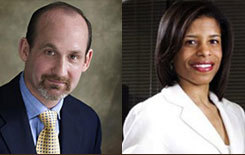CHICAGO, IL--(Marketwired - Sep 15, 2015) - Sometimes referred to as liposculpture or lipoplasty, liposuction can often be an excellent option for men and women interested in removing stubborn fat accumulations from various regions of the body, states Chicago plastic surgeon Lorri Cobbins, MD. Some of the most common treatment areas include -- but are not limited to -- the abdomen, hips, inner and outer thighs, back, chest, arms and neck, she notes, adding that fat tissues in these locations tend to be resistant to even the healthiest of diets and most stringent exercise routines for many people.
At The Aesthetic Institute of Chicago, Dr. Cobbins and her colleague, Dr. Brian Braithwaite, offer several different liposuction techniques, each of which she says involves the injection of a local anesthetic and salt water (tumescent fluid) into the targeted area to help minimize discomfort and postoperative side effects, such as bruising. What distinguishes the techniques from one another, she explains, is the technology used to disrupt the fat. For example:
- Traditional suction-assisted liposuction (SAL) - This liposuction method disrupts fat via a cannula attached to a suction device.
- Power-assisted liposuction (PAL) - This liposuction technique also involves the use of a cannula, though the cannula vibrates to disrupt fat with improved efficiency.
- Ultrasound-assisted liposuction (UAL) - This approach to liposuction employs targeted sound waves to disrupt fat.
- Laser-assisted liposuction - This liposuction procedure uses laser energy to essentially liquefy fatty tissue.
Despite these dissimilarities, Dr. Braithwaite notes that each fat reduction method necessitates several small incisions through which the associated cannula is inserted during the procedure, and fat is removed. These incisions typically heal inconspicuously, he adds, and the results from liposuction can often be permanent as long as the individual maintains a relatively stable weight through diet, exercise, and an overall healthy lifestyle.
Ultimately, when considering liposuction, Dr. Braithwaite and Dr. Cobbins stress the importance of seeking a board certified plastic surgeon who has experience with multiple techniques, as every approach offers its own advantages and disadvantages. By doing so, they say the safest, most effective liposuction procedure can be selected based on the patient's unique needs and goals.
About Lorri Cobbins, MD
Dr. Cobbins attended Saint Louis University to obtain her medical degree. She then completed a five-year Otolaryngology residency and her formal Plastic and Reconstructive Surgery training at the University of Louisville Medical Center. In addition to being certified by the American Board of Plastic Surgery and a Fellow of the American College of Surgeons, she remains active in the American Society of Plastic Surgeons.
About Brian Braithwaite, MD
Dr. Braithwaite obtained his medical degree from the University of Illinois College of Medicine, after which he went on to complete his Plastic Surgery training at the University of Louisville. In addition to being certified by the American Board of Plastic Surgery, he is a Fellow of the American College of Surgeons, as well as an active member of the American Society of Plastic Surgeons and the American Society for Aesthetic Plastic Surgery.
Dr. Cobbins and Dr. Braithwaite are both available for interview upon request.
For more information, visit aestheticinstitutechicago.com and facebook.com/drbraithwaite.
To view the original source of this press release, click here: https://www.aestheticinstitutechicago.com/news-room/plastic-surgeons-in-chicago-detail-various-liposuction-techniques/
Contact Information:
The Aesthetic Institute of Chicago
601 West Randolph Street
Chicago, IL 60661
(312) 258-9100
Rosemont Media
(858) 200-0044
www.rosemontmedia.com
